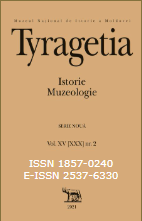The evidence of the Ottoman period at the “Diluch” compound in Anapa
The evidence of the Ottoman period at the “Diluch” compound in Anapa
Author(s): Olga KladchenkoSubject(s): Archaeology, Cultural history, Social history, The Ottoman Empire
Published by: Muzeul Naţional de Istorie a Moldovei
Keywords: Anapa fortress; tobacco pipes; aftabas; faience; pottery; Ottoman period;
Summary/Abstract: The article is a review of the discoveries of the Ottoman era, recovered during the 2020 excavations on the territory of the Anapa fortress and represented by a significant amount of pipes, faience cups for coffee, fragments of candlesticks, aftabes and braziers for coals. The typological diversity of pipes and stamps on them, faience artifacts, including those marked with the marks of craftsmen, is described. Special attention is paid to the group of ceramic objects, known as "footed basins". In general, the collection of objects represents a very interesting complex of discoveries, since the fortress was under Ottoman subordination for only 46 years. Such complexes, dated in reduced terms, are particularly informative and important for specifying the chronology of ceramic objects, including pipes, the dating of which is not developed in sufficient fractional detail. The layer disturbed by contemporary and previous constructions cannot be called a closed complex, but it is highly unlikely that, after the fortress came under Russian rule, typical Ottoman material continued to be introduced there.
Journal: Tyragetia (Serie Nouă)
- Issue Year: XV/2021
- Issue No: 2
- Page Range: 75-95
- Page Count: 21
- Language: English

